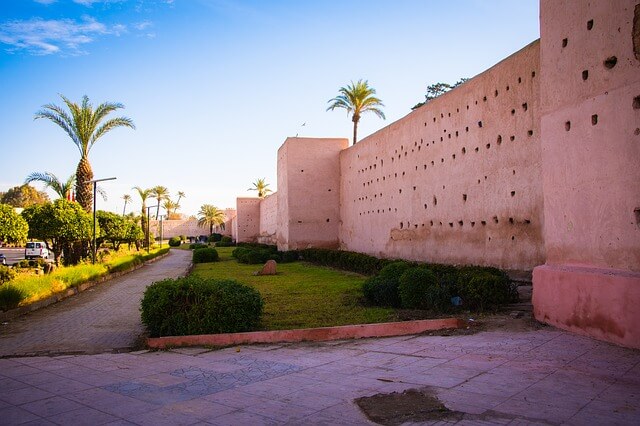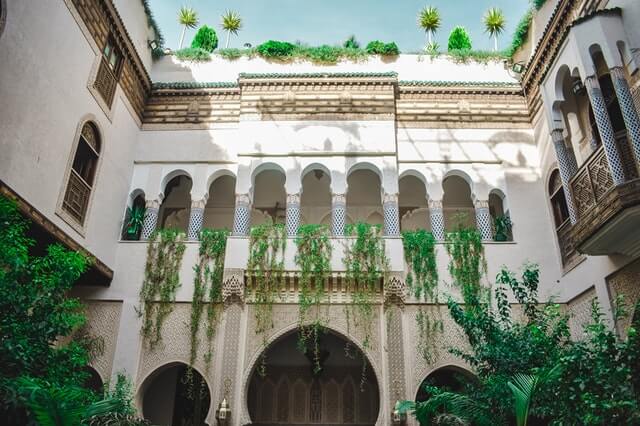Meknes one of the four Imperial cities of Morocco, was founded in the 10th century by a Berber tribe called the Meknassa! But it was the Alaouite sultan Moulay Ismaïl who put the city on the map when he chose it as the site for his new capital in the late 17th century.
A great admirer of France’s Louis XIV, the sultan set about building an imperial city to rival the Sun King’s Palace of Versailles. Christian slaves and local tribesmen labored for years to realize Ismail’s grandiose plan, which comprised a complex of 24 royal palaces; with mosques, barracks and ornamental gardens, surrounded by four sets of massive defensive walls. Following the death of Moulay Ismaïl, the Imperial City fell into ruin, but the 20th century brought restoration and rejuvenation.
Modern Meknès city
Most visitors stay in the Ville Nouvelle, where the majority of the comfortable hotels are concentrated. If you arrive by train, be sure to alight at the Abdelkader station, the first stop coming from Rabat capital city of Morocco or Tangier. It is closer to the city-centre hotels than the main railway station, which is a little further on.
One of the best panoramas of the city can be enjoyed at the four-star Hotel Transatlantique. From its hilltop vantage point you can look across the Boufekrane valley to the walls, rooftops and minarets of ancient Meknes ranged along the heights.
The Imperial City is so extensive that it can be rather tiring to explore it all on foot, allow for at least two to three hours of walking. If you don’t want to walk, you can take a tour by bus, or engage a taxi driver to show you around the principal sights of the city.
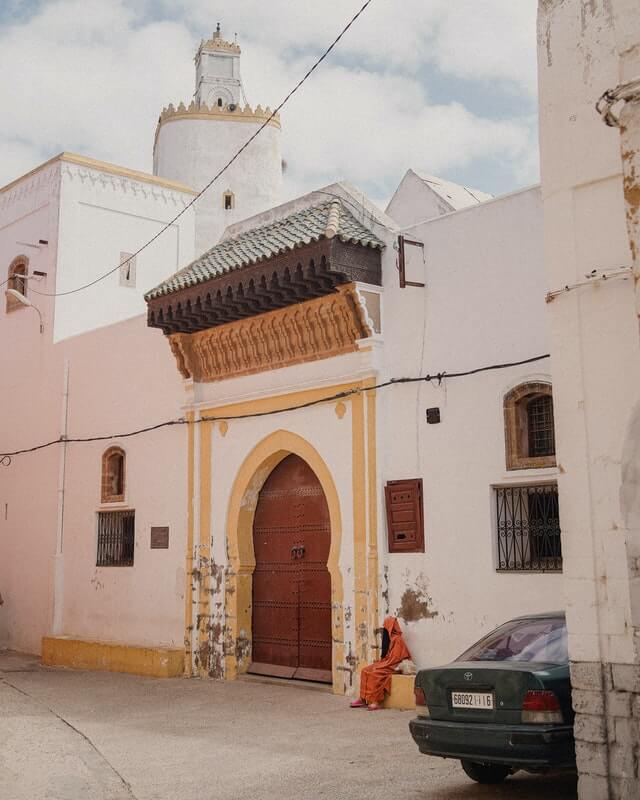
Place el Hédim
From Avenue Hassan II, the main avenue of the new town, a bridge crosses the valley of the Oued Boufekrane and leads uphill to Place el Hédim, in the heart of the old city. The square has recently been renovated, and now boasts fancy streetlamps, fountains, and a mock-Andalusian arcade full to the brim of handicraft stalls.
Gateway of Bâb Mansour
Dominating the southern end of the square is the massive, monumental gateway of Bâb Mansour, perhaps Moulay Ismail’s most impressive legacy. The intricate ornamentation and richly colored tiles evoke the wealth and splendor of old Meknes and its imperial court. To the right of the Bâb Mansour is a smaller gate in similar style, the Bâb Jamaa en Nouar, less imposing, but still very grand.
“Massive walls enclose Sultan Moulay Ismail’s Imperial City in Meknes.”
Koubbet el Khiyatîn
Pass through the Bâb Mansour and you’ll find yourself on the great expanse of Place Lalla Aouda; continue through a second gate, the Bâb el Filala, to another square. The small, domed building to your right is the Koubbet el Khiyatîn, where the great sultan once received foreign ambassadors. A stairway beneath the pavilion leads down to the massive subterranean vaults, which are said to have been used as a prison for the European slaves who labored on the construction of the Imperial City. Legend has it that the underground chambers ran for over 7km (4 miles), and that up to 40,000 slaves were incarcerated here each night.
Moulay Ismail’s Tomb “Meknes, Morocco”
On the far side of the square an archway leads to the triple-arched entrance of Moulay Ismail’s Tomb on the left. The doorway to the tomb enclosure is magnificent, and like the rest of the tomb complex it was renovated during the reign of Mohammed V. Once through the door, you pass through several elegant courtyards. Grass mats at the threshold of the memorial mosque remind you to leave your shoes and proceed in stockinged feet; the tomb is a sacred place of pilgrimage and prayer, and while non-Muslims are allowed into the ante-chamber, they must not enter the sanctuary of the mosque proper.
From the ante-chamber you can peek into the memorial mosque, where Sultan Moulay Ismail’s tomb rests beneath sumptuously decorated horseshoe arches; watched over by four ornate French grandfather clocks, a gift to the sultan from RA King Louis XIV in 1700.
Must Read: When Is The Best Time To Visit Morocco? | Full Weather Info
Bâb er Rih
On leaving the tomb, take a left turn and follow the road through the left-hand arch of the Bâb er Rih (Gate of the Winds) to emerge into a rather forbidding 800m (875yd) long corridor squeezed in between two mighty walls. On the other side of the wall to the right is the Dar el Makhzen, or Royal Palace (not open to visitors), where the monarch stays during his visits to Meknes.
Héri es Souani
At the far end turn right past the main entrance to the Royal Palace and continue through another gate to reach the Dar el Ma, also known as the Héri es Souani. This large, square, vaulted building, dating from the 17th century, served both as a granary and feed store for Moulay Ismail’s vast stables, which housed 12,000 steeds. The roof of the building now supports a pleasant café-garden with a fine view of the city and the huge Aguedal Basin, once used for the irrigation of the Imperial City’s vast and luxuriant gardens.
Dar el Beïda
The remains of Moulay Ismail’s tremendous stables are attached to the granary. A short distance to the south proudly stands the Dar el Beïda, a thick-walled fortress of vaguely Eastern European aspect. Built as a sultan’s palace in the late 18th century, it’s been reconverted to serve as a military officers’ training school.
Meknes Medina, Morocco
Dar Jamaï
Across Place el Hédim from the Bâb Mansour is an entrance gate into the Medina, and right beside it is the door of the Dar Jamaï; the centuryold private palace of a minister of state, which houses Meknes’s arts museum. The collections include wood carvings, silk embroidery, carpets from the Middle Atlas, tile-work, wrought-ironwork and jewellery. The reception room upstairs is fully – and somewhat eclectically furnished. But the palace itself is perhaps the major attraction. Bearing in mind that its fanciful architecture and intricate arabesque decoration were not intended for the sultan but merely for one of his ministers; you can imagine what splendors must lie within the Royal Palace.
The Grand Mosque
A narrow alley to the right of the Dar Jamaï leads to the Grand Mosque with its elaborate entrances, ornate gates, green-tiled minaret and red-tiled roofs and cupolas. This is the largest and most sacred of the dozens of mosques in the city. It’s also one of the oldest.
Bou Inania Medersa
Across the street from the mosque is the Bou Inania Medersa. The gardien will give you a complete and fact-filled tour of this fine old religious college, built by Abu el Hassan in the 14th century. It’s possible to climb to the roof for a bird’s-eye view of the mosque and Meknes Medina.
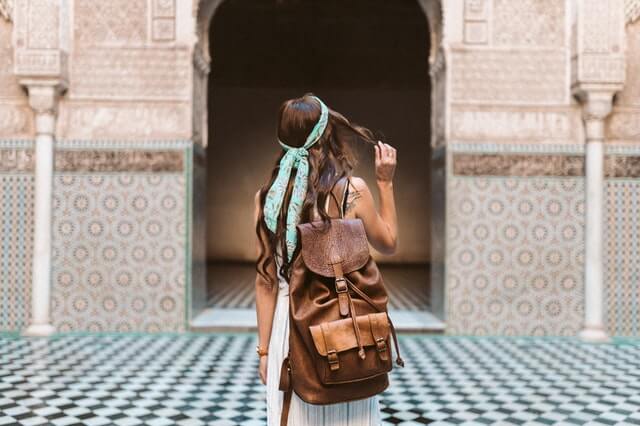
Souk en Nejjarîn
Along the Rue du Souk en Nejjarîn, a variety of modern shops break the solid ranks of traditional carpenters’ shops from which the street takes its name. But here and there you can still find craftsmen working away with traditional tools at benches worn smooth from centuries of use.
Must Read: Eid Al Mawlid Annabawi In Morocco | How & When to Celebrate it
The Meknes Medina atmosphere
The Meknes Medina is one of the tidiest in Morocco, and though many shops are in traditional style, others are strictly modern. As you explore the tortuous labyrinth of streets! You’ll encounter the mingled scents of sweet incense, tangy citrus fruits, aromatic wood from the joiners’ shops, and grilling meat from the numerous food stalls.
Glittering embroideries hang fluttering in the tiny windows of tiny shops, and men and boys chat while sewing away at jellabas and caftans. Other shops are filled from floor to ceiling with bales of cloth and spools of silken thread in every shade imaginable.
Must Read: What language in morocco do they speak? Useful guide
Children fill cans with water from bubbling fountains decorated with colored faïence, while bearded old men shuffle out of the Grand Mosque after noontime prayers, and put on their shoes. The entrance to the mosque is carefully protected from the outside world by a carved wooden screen. Nearby, mighty blue-painted doors mark the entrance to an ancient souk specializing in blankets and jellabas. This is the Kissaria el Dlala, always crowded (except on Fridays) with men watching the action as individual blankets and garments are sold at auction.
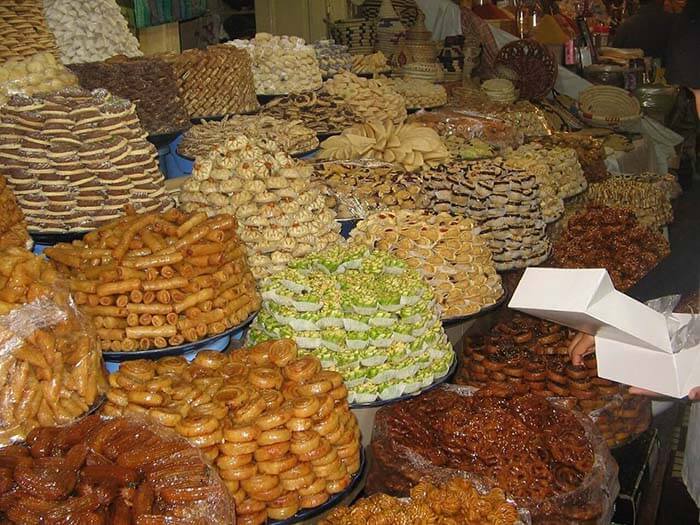
Souk en Nejjarîn
Along the Rue du Souk en Nejjarîn, a variety of modern shops break the solid ranks of traditional carpenters’ shops from which the street takes its name. But here and there you can still find craftsmen working away with traditional tools at benches worn smooth from centuries of use.
Where to stay in Meknes, Morocco
For the first-time visitor, starting a journey in Meknes is a gentle, relaxed way to be introduced to the country’s powerful culture. Staying there, in one of the Riads offering luxurious bed and breakfast accommodation around the beautiful courtyards of newly restored palacial homes! Is a memorable and enriching experience.
Must Read: Where to stay in Morocco in 2021 | Accommodation in Morocco
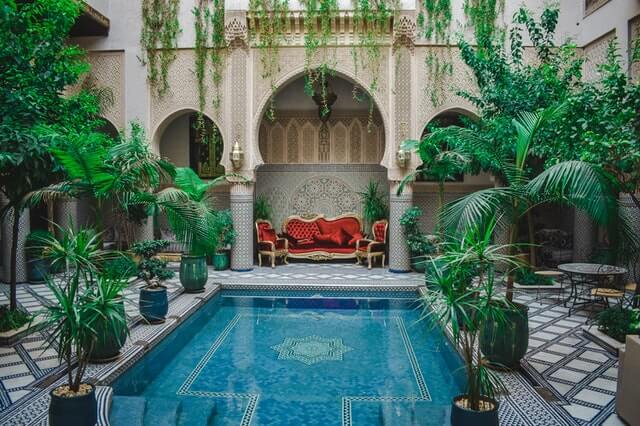
The best day trip outside of Meknes
Nearby, to the north lie the highly interesting Roman site of Volubilis and the equally interesting holy town of Moulay Idriss; founded in AD 788, where Moroccans too poor to travel to Mecca undertake their pilgrimage. Every year at the end of August this is the scene of one of the country’s most spectacular religious festivals in Morocco or moussem. To the south the great cedar forests of Azrou and Ifrane and the Dayet Aaoua Lake near Immouzzer du Kandar offer both cool relief from summer heat and wonderful trekking.
Must Read: 10 Best Places To Visit in Morocco in 2021
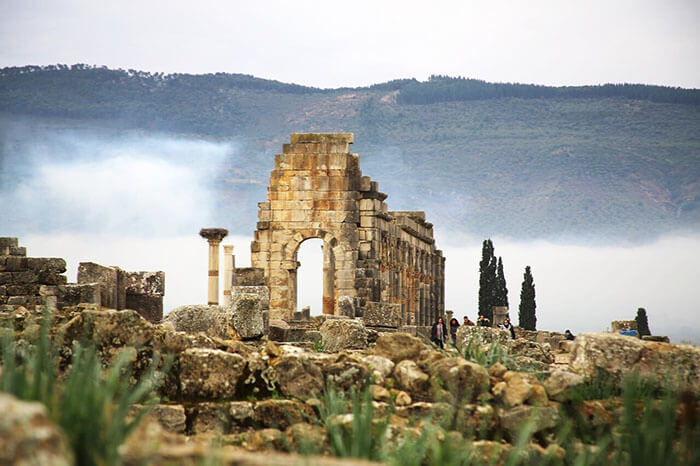
How to get to Meknes
With excellent communications at the crossroads of both train lines and major roads, including the motorway from Casablanca; Meknes is easily accessible. Its relative proximity to northern ports, to the west coast, to both the Middle and High Atlas mountains, and just sixty kilometers from Fes, makes it an ideal centre from which to explore the Northern parts of Morocco.
The main destination where travelers come from is Fez; here is the different way to transit between these two amazing cities.
- By bus, we suggest to take CTM Company, is one of the trusted company in Morocco, There are many departures From Fez to Meknes by CTM.
- By train, is a very good option to get from Meknes to Fez, and very comfortable, it takes 40 mins. In each hour there is a departure from Fez to Meknes.
- By Taxi, one seat in a shared taxi will you coast 25 to 30 MAD, if you want to take it alone the price is around 150 MAD = 15$.
- Transfer company, If you want to benefit a private tour, you have to book a tour with a transfer company.
Must Read: High Atlas Mountains in Morocco | Where the Mountains are law.
You need more information or suggestion about your travel to Meknes? Have you visited this imperial city? You want more tips for your Morocco travel? Please feel free to drop me a message in the comments below.
FAQ About best things to do in Meknes, Morocco
Meknes, a city teeming with historical richness, offers a plethora of engaging activities. Discover the grandeur of the Bab Mansour gate, delve into the intricate architecture of the Mausoleum of Moulay Ismail, wander through the vibrant atmosphere of the Meknes Medina, explore the ancient ruins of Volubilis, and savor the tranquility of the Heri es-Souani granaries.
The Bab Mansour gate is an architectural marvel and a must-visit in Meknes. Its intricately adorned facade and colossal structure showcase the grandeur of Moroccan craftsmanship. Visitors can marvel at the stunning tilework and capture breathtaking photos, making it a quintessential stop for those exploring the city’s historical wonders.
The Mausoleum of Moulay Ismail holds profound historical and cultural significance in Meknes. Serving as the final resting place of the Sultan Moulay Ismail, the mausoleum is revered for its exquisite design and peaceful ambiance. Visitors can witness traditional Moroccan architecture and pay respects to the influential ruler who played a key role in shaping the city’s heritage.
The Meknes Medina is a sensory delight, offering unique experiences to tourists. Navigate through bustling markets where vibrant stalls showcase local crafts, textiles, and spices. Engage with friendly locals, sample traditional Moroccan cuisine at authentic eateries, and absorb the lively atmosphere that defines the heart of Meknes.
A visit to the ancient ruins of Volubilis is a journey back in time. Recognized as a UNESCO World Heritage site, these well-preserved Roman ruins provide a glimpse into Morocco’s ancient history. Stroll through the intricate mosaics, marvel at the architecture, and imagine the bustling life that once thrived in this archaeological gem, making it a recommended excursion for those exploring Meknes.

